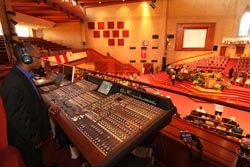Broadcasting The Message

At New York's Greater Allen Cathedral, director of technology Obed James relies on Yamaha consoles in part to feed his in-house broadcast facility. As contemporary houses of worship grow more sophisticated in the use of production technology-and as the price of that technology continues to fall-the prospect of broadcasting services isn't just a novel idea: it's a reality. While mega churches have been doing so for years, mid-sized and even some smaller facilities are adapting broadcast systems to not only transmit to local television stations or even secondary facilities off campus, but around the world, via the internet.
"Not all churches could broadcast before because it was cost prohibitive for them. Now with streaming on the internet, everybody can broadcast," said David Taylor, account manager for Ford Audio-Video Systems, a systems integration company headquartered in Oklahoma City, OK.
Hi-Def Hits
One of the most significant developments is the market's adoption of high-definition video and widescreen formatting. In an effort to address younger, more visual audiences, houses of worship face the challenge of keeping up with the secular world. "Churches used to work with low-resolution video," said Ludovic Mellot, vice president of Analog Way. "They have now noticed that in order to provide their audience with the best image they had to convert everything to high resolution. Some larger houses of worship have completely abandoned SDTV, even for their broadcasting, and now work in full HDTV."
This is largely driven by the general public's increasing exposure to high-definition images, either through visiting other churches, or even at home. "I think that once people have had the HDTV/high-resolution experience, they obviously want to get the same in their own church," Mellot said.
High definition also offers those organizations with several locations to create a feeling of intimacy with their worshippers: crystal clear images give the illusion that the person leading the service is right there, in the room-even if they are preaching from a different campus.
"It's used in larger churches where they want the image to look absolutely realistic, as if the praise leader is in the room," said Peter Taylor, national sales manager in the Value-Added Distributor department at Barco. "It's about making it look real, so that people can interact with him and feel more comfortable."
AV Overhaul
This shift to high definition requires churches to invest in the cameras and projection equipment that supports HD video. Color balancing also plays a significant role in broadcast. "What the camera sees and what you see when something is being broadcast is at a much warmer temperature than what you would be looking at on a computer screen," Peter Taylor explained. "The projectors and the equipment does have to have some complexity to it if you want to do a good job."
A daily selection of the top stories for AV integrators, resellers and consultants. Sign up below.
Mellot points out that the best-case scenario is to replace every content source with true, native high-definition sources. He concedes, however, that this can be costly for most churches. "Furthermore, the system has to be open because there will always be a time when a NTSC tape, for example, has to be displayed," he said.
The second-best approach, according to Mellot, involves more of a migration toward high definition, starting with the investment in a quality high-definition display, projector, or flat panel, depending on the environment and the required image size. "Then in order to convert any source to match the resolution of the selected display device they will need a seamless switcher with universal inputs," he said. This allows the engineer to take any kind of video-be it high or low resolution-and convert it to the required resolution while improving the signal's overall quality. "This will enable them to keep any source they want and to start investing at their leisure in high-def sources."
Operation Modernization
Larger churches that are already doing broadcast-especially those whose services are run on local cable stations-generally have at least one, if not several, full-time engineers to oversee operations. David Taylor argues, however, that the systems have progressed to the point where churches that wish to stream to a website, for example, don't necessarily require a team of full-time personnel, depending on what they wish to achieve. "Technology has moved to the point where there are video switchers that have frame synchronizers on any input, so an engineer doesn't have to be there to adjust the signals," he said. This dictates a need for education, and systems contractors are well positioned to act as that primary information source for the church customer. "We try to educate the customer more up front. 'If you want to get into high definition, here are the things that are required,'" David Taylor illustrated.
Carolyn Heinze has covered everything from AV/IT and business to cowboys and cowgirls ... and the horses they love. She was the Paris contributing editor for the pan-European site Running in Heels, providing news and views on fashion, culture, and the arts for her column, “France in Your Pants.” She has also contributed critiques of foreign cinema and French politics for the politico-literary site, The New Vulgate.
